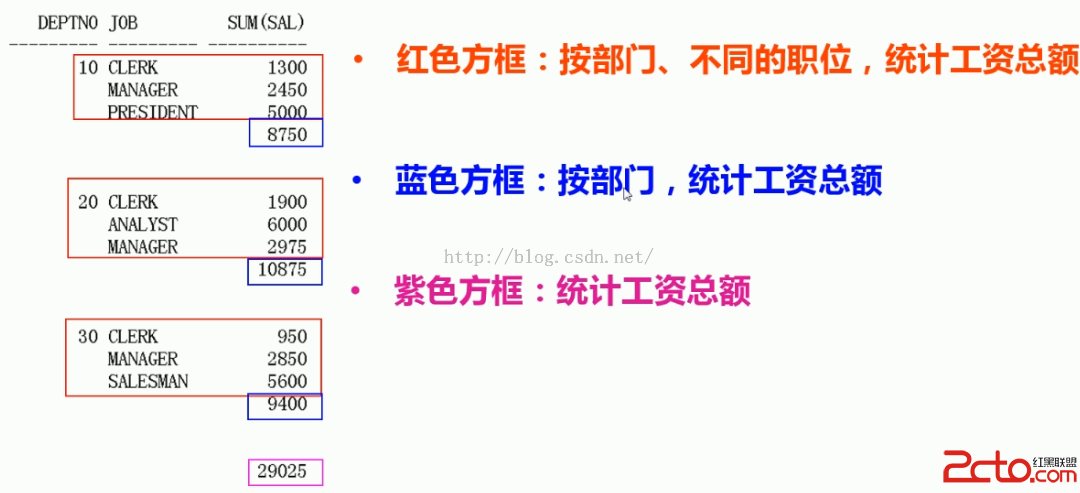在學習高級查詢之前,我們先了解一下如何查看Oracle數據庫中的所有表。因為我們要使用到Oracle數據庫中SCOTT用戶下的幾張表(這些表是Oracle數據庫自帶的表)。

分組查詢 分組函數的概念:分組函數作用於一組數據,並對一組數據返回一個值。 常用的分組函數:AVG、SUM、MIN、MAX、COUNT、WM_CONCAT(行轉列) 語法:
 分組函數的使用 AVG(平均值)和SUM(合計)函數 1、求出員工的平均工資和工資的總額 select avg(sal),sum(sal) from emp; MIN(最小值)和MAX(最大值)函數 2、求出員工工資的最大值和最小值 select max(sal),min(sal) from emp; COUNT(計數)函數 3、求出員工的總人數 select count(*) from emp; select count(empno) from emp;
分組函數的使用 AVG(平均值)和SUM(合計)函數 1、求出員工的平均工資和工資的總額 select avg(sal),sum(sal) from emp; MIN(最小值)和MAX(最大值)函數 2、求出員工工資的最大值和最小值 select max(sal),min(sal) from emp; COUNT(計數)函數 3、求出員工的總人數 select count(*) from emp; select count(empno) from emp;  DISTINCE(distinct)關鍵字(DISTINCT用於去掉重復的記錄) 4、求出部門數 select count(deptno) from emp; select deptno from emp; select count(distinct deptno) from emp;
DISTINCE(distinct)關鍵字(DISTINCT用於去掉重復的記錄) 4、求出部門數 select count(deptno) from emp; select deptno from emp; select count(distinct deptno) from emp; WM_CONCAT:行轉列 示例:select deptno,wm_concat(ename) from emp group by deptno;
WM_CONCAT:行轉列 示例:select deptno,wm_concat(ename) from emp group by deptno; 
 分組函數與空值 1、統計員工的平均工資 select sum(sal)/count(*) 一,sum(sal)/count(sal) 二,avg(sal) 三 from emp;
分組函數與空值 1、統計員工的平均工資 select sum(sal)/count(*) 一,sum(sal)/count(sal) 二,avg(sal) 三 from emp; 

 使用GROUP BY子句數據分組(GROUP BY可以作用在一個列上,也可以作用在多個列上) group by子句的使用 使用單個列分組 示例:求每個部門的平均工資,要求顯示:部門號,部門的平均工資 select deptno,avg(sal) from emp group by deptno;
使用GROUP BY子句數據分組(GROUP BY可以作用在一個列上,也可以作用在多個列上) group by子句的使用 使用單個列分組 示例:求每個部門的平均工資,要求顯示:部門號,部門的平均工資 select deptno,avg(sal) from emp group by deptno; 

 使用多個列分組 示例:按部門、不同的職位,統計員工的工資總額 select deptno,job,sum(sal) from emp group by deptno,job; select deptno,job,sum(sal) from emp group by deptno,job order by deptno;
使用多個列分組 示例:按部門、不同的職位,統計員工的工資總額 select deptno,job,sum(sal) from emp group by deptno,job; select deptno,job,sum(sal) from emp group by deptno,job order by deptno;  非法使用組函數:
非法使用組函數:  修改:
修改:  使用HAVING子句過濾分組結果集
使用HAVING子句過濾分組結果集  求平均工資大於2000的部門,要求顯示:部門號,平均工資 select deptno,avg(sal) from emp group by deptno having avg(sal)>2000
求平均工資大於2000的部門,要求顯示:部門號,平均工資 select deptno,avg(sal) from emp group by deptno having avg(sal)>2000 
 where與having的區別 相同點:都是過濾結果集 不同點: 不能再WHERE子句中使用組函數(注意)。 可以在HAVING子句中使用組函數。
where與having的區別 相同點:都是過濾結果集 不同點: 不能再WHERE子句中使用組函數(注意)。 可以在HAVING子句中使用組函數。  where與having通用的情況 select deptno,avg(sal) from emp group by deptno having deptno=10; select deptno,avg(sal) from emp where deptno=10 group by deptno; having 先分組 後過濾 where 先過濾 後分組 where使得分組記錄數大大降低,從而提高效率 注意:where子句中不能使用組函數 在分組查詢中使用order by字句 示例:求每個部門的平均工資,要求顯示:部門號,部門的平均工資並且按照工資升序排列 select deptno,avg(sal) from emp group by deptno order by avg(sal); select deptno,avg(sal) 平均工資 from emp group by deptno order by 平均工資; select deptno,avg(sal) 平均工資 from emp group by deptno order by 2; 可以按照:列,別名,表達式,序號進行排序
where與having通用的情況 select deptno,avg(sal) from emp group by deptno having deptno=10; select deptno,avg(sal) from emp where deptno=10 group by deptno; having 先分組 後過濾 where 先過濾 後分組 where使得分組記錄數大大降低,從而提高效率 注意:where子句中不能使用組函數 在分組查詢中使用order by字句 示例:求每個部門的平均工資,要求顯示:部門號,部門的平均工資並且按照工資升序排列 select deptno,avg(sal) from emp group by deptno order by avg(sal); select deptno,avg(sal) 平均工資 from emp group by deptno order by 平均工資; select deptno,avg(sal) 平均工資 from emp group by deptno order by 2; 可以按照:列,別名,表達式,序號進行排序 


 分組函數的嵌套 示例:求部門平均工資的最大值 1、通過AVG函數求出每個部門的平均工資 2、嵌套MAX函數求出部門平均工資的最大值 select max(avg(sal)) from emp group by deptno;
分組函數的嵌套 示例:求部門平均工資的最大值 1、通過AVG函數求出每個部門的平均工資 2、嵌套MAX函數求出部門平均工資的最大值 select max(avg(sal)) from emp group by deptno;  group by語句的增強 break on deptno 2 相同部門號的值只顯示一次,不同的部門號之間跳過兩行 set pagesize 30 每頁顯示30條記錄
group by語句的增強 break on deptno 2 相同部門號的值只顯示一次,不同的部門號之間跳過兩行 set pagesize 30 每頁顯示30條記錄 




 SQL*Plus的報表功能 報表包括:標題,頁碼,別名等
SQL*Plus的報表功能 報表包括:標題,頁碼,別名等 

